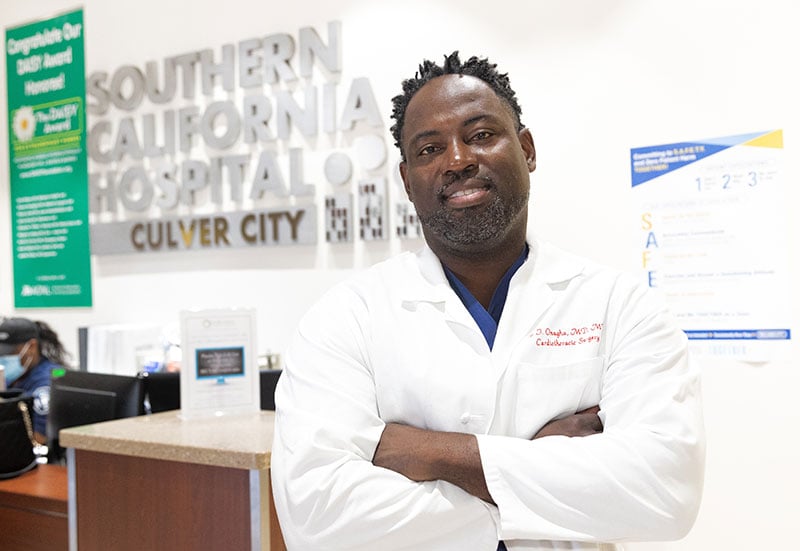Pioneering Treatment for Rib Fractures

It happens in an instant. A car runs a red light, crashing into the side of your vehicle. The impact leaves you in shock, and suddenly you feel a severe pain in your chest. It hurts to move around or even breathe.
Thoracic trauma makes up 10% to 15% of all trauma-related hospital admissions, and a fractured rib is the most frequently encountered injury within those cases. With enough force, ribs will crack or break, causing a significant amount of pain.
“Rib fractures typically occur when there is a trauma to the chest, which can be related to, most commonly, a motor vehicle accident or a fall,” said Dr. Osita Onugha, a board-certified thoracic surgeon at Southern California Hospital at Culver City and assistant professor of thoracic surgery at St. John’s Cancer Institute. “We often see this type of injury in the elderly.”
If a bone breaks elsewhere in the body, such as in the leg or arm, treatment usually involves immobilization with a cast so that it can rest and heal. A broken rib, however, will inevitably move with every breath or cough. Patients may end up taking shorter breaths to relieve some discomfort, a condition called hypoventilation which can lead to lower levels of oxygen in the blood and possibly pneumonia.
Simple, hairline rib fractures will heal on their own with the help of over-the-counter pain relievers. But multiple breaks or a displaced fracture, where the ends of the bones no longer line up with one another, would benefit from more serious treatment.
“For the last 70 years, we treated rib fractures with actually nothing,” Dr. Onugha said. “We would give you strong pain medication. The problem is that bones take anywhere from 6 to 12 weeks to heal, sometimes longer, which puts people at risk for opioid dependence.”
During his training at Stanford University six years ago, Dr. Onugha pioneered a new kind of minimally invasive surgery for fractured ribs called extra-thoracic video-assisted thoracic surgery (VATS).
Previous procedures used long incisions and open exposure of the chest to stabilize the broken ribs with plates and screws. Extra-thoracic VATS, on the other hand, needs only very small cuts to access the ribs. A tiny camera and surgical instruments are inserted into the chest through these cuts, which guides the surgeon performing the procedure. In addition, a balloon catheter is inflated in the chest cavity to enable greater access to the ribs.
After years of perfecting the process, Dr. Onugha now performs extra-thoracic VATS regularly at Southern California Hospital at Culver City. Typically, patients will spend only one night in the hospital and experience immediate relief afterward.
“I’ve done the surgery on patients in their 20s, and the oldest was someone who was 97 years old,” he said. “They’ll be in excruciating pain and miserable one day, then literally, the morning after surgery, they feel so much better.”
Dr. Onugha is a Fellow of the American College of Surgeons.
